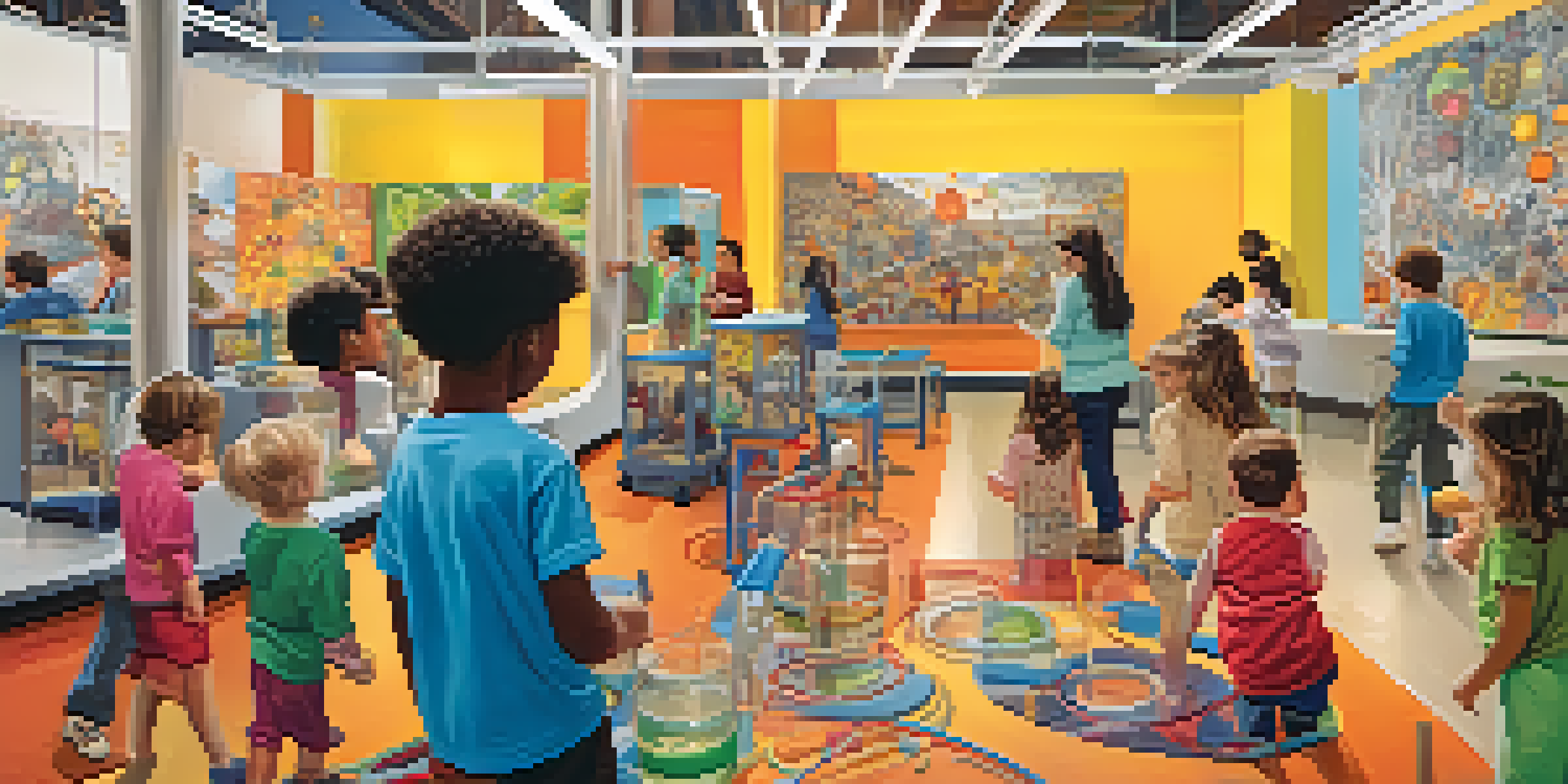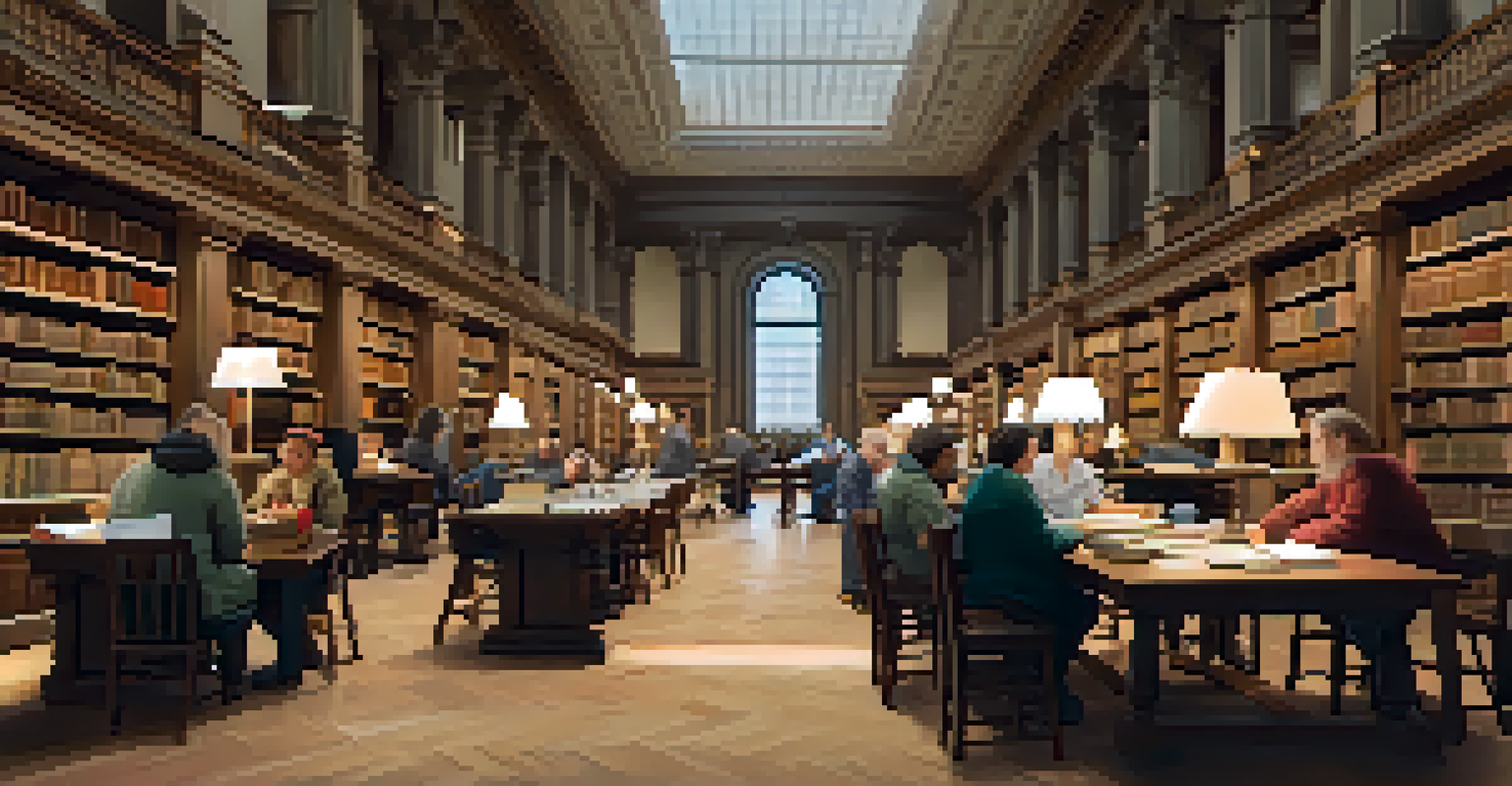Cultural Institutions: Fostering Education in NYC

The Role of Cultural Institutions in Education
Cultural institutions play a vital role in education, serving as gateways to knowledge and creativity. In New York City, museums, galleries, and theaters provide rich resources that complement traditional classroom learning. These spaces foster curiosity and encourage critical thinking, allowing learners to engage with art, history, and science in immersive ways.
Education is not preparation for life; education is life itself.
For instance, visiting the American Museum of Natural History can ignite a passion for science in students, making topics like evolution and ecology come alive. Such experiences help bridge the gap between textbook learning and real-world applications. By integrating cultural experiences into education, we can cultivate a deeper understanding of the world around us.
Moreover, these institutions often offer workshops, lectures, and guided tours that align with school curricula, making them invaluable educational partners. Through collaboration with educators, cultural institutions enrich the learning experience, ensuring that education is not confined to the classroom.
Access and Inclusivity in Cultural Education
One of the most significant aspects of cultural institutions in NYC is their commitment to access and inclusivity. Many museums and cultural organizations offer free or reduced-price admission programs, making it easier for families from diverse backgrounds to participate in educational activities. This democratization of culture ensures that everyone has the opportunity to learn and grow.

Programs like 'Museum Mile Festival' highlight this commitment, where various institutions open their doors for free, allowing thousands to explore art and history. Additionally, many institutions provide specialized tours and resources for individuals with disabilities, showcasing their dedication to inclusivity. By removing barriers, these institutions foster a learning environment that welcomes all.
Cultural Institutions Enhance Learning
Cultural institutions enrich education by providing immersive experiences that bridge classroom learning with real-world applications.
Furthermore, partnerships with local schools can enhance access to cultural education. Schools often collaborate with cultural organizations to create tailored programs that meet the needs of their students. This synergy not only enriches the educational experience but also strengthens community ties.
Innovative Programs for Young Learners
Cultural institutions in NYC have developed innovative programs specifically designed for young learners. These initiatives often blend art and education, providing hands-on experiences that inspire creativity and critical thinking. For example, programs at the Brooklyn Children's Museum encourage children to explore science through interactive exhibits and engaging workshops.
The arts are not a luxury; they are a necessity for living.
Such programs are essential in teaching children the importance of creativity and collaboration. By engaging young minds in the arts and sciences, these institutions pave the way for future generations to appreciate culture and innovation. This early exposure can lead to lifelong learning habits, sparking interest in fields like technology, design, and performance arts.
Moreover, these institutions often host summer camps and after-school programs that reinforce learning outside the classroom. By creating a fun and engaging environment, cultural institutions nurture a love for learning that lasts well into adulthood.
Adult Education and Lifelong Learning Opportunities
Cultural institutions also cater to adult learners, offering a range of educational opportunities that promote lifelong learning. From workshops to lectures, these programs enable adults to explore new interests or deepen their knowledge in specific subjects. For instance, the New York Public Library provides numerous free classes and events, making education accessible to all.
Additionally, many institutions host discussion panels featuring experts in various fields, allowing adults to engage in meaningful conversations about current topics. These events create a vibrant community where individuals can learn from one another and share diverse perspectives. This interaction not only enriches personal growth but also fosters a sense of belonging.
Commitment to Access and Inclusivity
Many cultural organizations in NYC strive for inclusivity by offering free admission programs and specialized resources for diverse communities.
Furthermore, cultural institutions often collaborate with universities and organizations to provide certification programs and professional development courses. This partnership ensures that adult learners can acquire new skills and qualifications, making cultural education a valuable resource for career advancement.
Connecting Communities Through Cultural Engagement
Cultural institutions serve as hubs for community engagement, connecting people from all walks of life. By hosting events, festivals, and exhibitions, they create spaces where individuals can come together to celebrate diversity and explore shared interests. This connection fosters a sense of belonging and enhances community cohesion.
For example, community days at places like the Museum of Modern Art encourage local residents to explore exhibits for free. These events often feature live performances, workshops, and discussions that highlight the talents and stories of community members. Engaging with local artists and educators allows communities to showcase their unique cultures and perspectives.
Moreover, cultural institutions often collaborate with local organizations to address community needs. Whether it’s through educational programs for underserved populations or providing resources for local schools, these institutions can make a significant impact. By prioritizing community connection, cultural institutions enrich not only individual lives but also the fabric of society.
The Impact of Technology on Cultural Education
In today's digital age, technology plays an increasingly important role in cultural education. Many institutions have embraced online platforms to reach wider audiences and enhance learning experiences. Virtual tours, webinars, and online workshops allow individuals to engage with culture from the comfort of their homes.
For instance, the Metropolitan Museum of Art offers virtual exhibitions that allow users to explore their vast collections without stepping foot inside. These digital resources are particularly beneficial for those who may not have the means to visit in person. By leveraging technology, cultural institutions can make education more accessible and engaging.
Embracing Technology in Education
Cultural institutions leverage technology to enhance learning through virtual experiences and interactive exhibits, making education more accessible.
Moreover, technology can enhance in-person experiences as well. Interactive exhibits that utilize augmented reality bring art and history to life, captivating visitors of all ages. By integrating technology into cultural education, institutions can create dynamic learning environments that resonate with today's learners.
Future Directions for Cultural Institutions in NYC
As we look toward the future, cultural institutions in NYC are poised to evolve and adapt to changing educational needs. The ongoing emphasis on diversity, equity, and inclusion will guide their initiatives, ensuring that all voices are represented. This commitment will drive the creation of new programs that reflect the rich tapestry of New York City’s communities.
Additionally, as technology continues to advance, institutions will likely explore innovative ways to engage audiences. From virtual reality experiences to interactive online learning platforms, the possibilities are endless. These advancements will not only enhance educational offerings but also make cultural experiences more immersive and accessible.

Ultimately, the future of cultural institutions in NYC lies in their ability to foster connections, inspire learning, and adapt to the ever-changing landscape of education. By prioritizing collaboration and community engagement, they will continue to play a crucial role in shaping the educational experiences of New Yorkers for years to come.